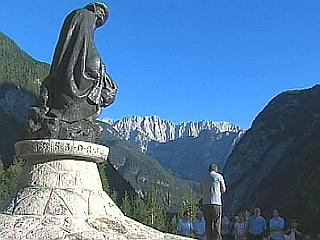
Julius Kugy was a renaissance man of the mountains. A scholar, a writer, and a mountaineer, he left an indelible mark on our understanding of the nature and the people of the Julian Alps, Slovenia’s highest mountain range.
Born in 1858 to a family of Slovenian descent in the town of Gorizia, Kugy was a product of an essentially pre-national Austro-Hungarian Empire. He grew up in a multiethnic and multilingual environment and rejected nationalism, seeing the nations of the Alps as essentially one people.
Even though Kugy took over his father’s trading company in the port city of Trieste, his heart belonged in the mountains. He explored a number of Alpine ranges but was most fond of the Julian Alps. He was equally at home in the lush valleys as he was among the barren, scraggly peaks. In an era when mountaineering, as we know it today, was still in its infancy, Kugy pioneered approximately 50 new routes, and was the first person to scale several important peaks.
During his travels, Kugy established warm bonds with the local inhabitants of the mountains, mostly with poachers from the Trenta Valley, who were familiar with every corner of the Julian Alps. The knowledge he had had gained from ordinary villagers not only helped him find his way around the Julian Alps, but also gave him a deep understanding of mountain life. He put his knowledge to use by writing a number of books about both the nature and the human traditions of the area. Some of his works became classics in the field of mountain literature and inspired new generations of authors.
Kugy was also a deeply musical man and founded two music societies in Trieste. His passion for botany inspired him to work with Swiss-born enthusiast Albert Bois de Chesne to create the Juliana Botanical Garden, which continues to attract tourists to Slovenia’s Trenta Valley.
However, one of Kugy’s main botanical obsessions ultimately turned out to be futile. For years, he sought the mythical plant scabiosa trenta, believed by many to be an exceedingly rare species native to the Trenta Valley. He never found it; as it later turned out, the flower never existed. (The specimen Kugy had seen belonged to an already discovered species.)
While he didn’t consider himself to be a Slovenian, Kugy helped the Slovenian resistance during World War II, and even rescued some mountaineers from a concentration camp. He died in 1944 in Trieste, before the war ended.
Today, a statue of Kugy – a work of the well-known Slovenian sculptor Jakob Savinšek -- stands in the Trenta Valley, overlooking Jalovec, Kugy’s favorite mountain. However, Kugy’s greatest legacy is an intangible one – a greater understanding of the mountains that play such an important role in defining Slovenian identity, and a commitment to friendship among the various peoples of the Alps.


































































